| Article ID | Journal | Published Year | Pages | File Type |
|---|---|---|---|---|
| 4317831 | Food Quality and Preference | 2010 | 9 Pages |
The conceptual profile of an unbranded product arises via three sources of influence: (i) category effect – how consumers conceptualise the product category: (ii) sensory effect – how the sensory characteristics of a particular product differentiate it from other products in the category: (iii) liking effect – the disposition of consumers to the category and how much they like a particular product. Assuming that category effects (conceptualisation and disposition) are constant across the set of products, it is anticipated that the conceptual differences apparent across the set of unbranded products would be driven, at least in part, by sensory differences. This study describes the application of best–worst scaling to conceptual profiling of unbranded dark chocolates and outlines novel data modelling procedures used to explore sensory/conceptual relationships.
